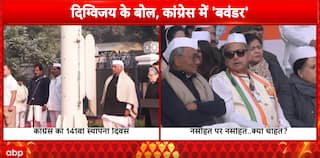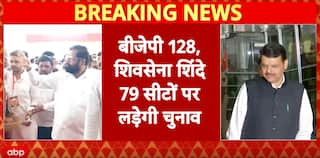India's Electric Mobility Dream: Is 2030 Achievable? Exploring Challenges Of EV Industry And The Solutions
India aims to have 30% electric vehicle penetration by 2030 to reduce carbon emission and move towards a greener future. Experts tell ABP Live what more needs to be done to accelerate the pace.

New Delhi: India has set an ambitious dream of cutting its carbon emission to 30 per cent by 2030, and electric vehicles are supposed to play a major role in achieving this goal. It is believed the electric mobility industry can bring the transformation India needs towards a sustainable environment to make the country cleaner and greener.
Union Road Transport and Highways Minister Nitin Gadkari had in March this year said more than 2.78 lakh electric vehicles (EVs) have been registered in the country in the 2023 calendar year until then.
The minister said that according to the data on the Vahan portal, the registration of EVs in India rose to 10,20,679 in 2022 from 3,29,808 in 2021. Till March 19 this year, a total of 2,78,976 registrations for electric vehicles were made, Gadakri informed.
As per the Economic Survey 2023, India's domestic EV market will grow at a compound annual growth rate (CAGR) of 49 per cent between 2022 and 2030 and is expected to see 1 crore units in annual sales by 2030. As per the Government of India’s Vahan portal, 999,949 EVs were sold in 2022.
This suggests the growing demand and understanding of consumers as far as EVs are concerned. But the question that is raised here is if the 2030 dream is achievable. Are we doing enough? If not, what more can be done? Where exactly are we lacking?
Speaking to ABP Live, several experts shared their views on how India’s ‘electric mobility’ dream is progressing and their understanding of the current and future picture of the Indian EV industry.
Need For Manufacturers, Machinery And Technology
There are many components that go into the making of an electric vehicle. The battery is the most important of it all — not only because it is a performance-defining part, but also because it captures the largest share of the total cost of the vehicle.
Expressing her view on this, Moushumi Mohanty, Senior Programme Manager, Electric Mobility Programme, Centre for Science and Environment (CSE), said India does not make EV batteries and since they are imported, they become costly.
To manufacture EV batteries, she said, it needs to be reviewed what kind of battery chemistries are being used in the country. Instead of materials such as nickel and cobalt, which are sourced from other countries, there are options such as lithium iron phosphate and lithium titanium oxide (LFP-LTO) that could offer a more sustainable solution.
“We need a supply chain. We need tie-ups with material suppliers and medium to long-term contracts to ensure supply security. We also need machinery. There are very few companies in the world that manufacture electrodes and other component-making machinery,” Mohanty said. “Since there are few machinery and equipment manufacturers, there are huge delays in supply. “The order pipelines of these companies have been very long. As a result, a few entities in India are working on manufacturing R&D to build them here in India.”
She admitted that it would be a long-term project, though added that this could be done with a funding programme.
Focusing On Small Manufacturers Will Boost Manufacturing
Explaining the government’s Production-linked Incentives scheme, Mohanty said the scheme assumes that funding large manufacturers will automatically create an integrated manufacturing eco-system and supply chain. “That cannot become a reality without a funded program focused on empowering the small manufacturer.”
Giving the example of Maruti, she said there were hardly any suppliers for it in the beginning. “The automotive supplier network we have in India was built from the ground up by developing small manufacturers and empowering them to build components. The EV industry needs a similar push.”
Internet Of Things And EVs As Future
In the changing world, the internet is destined to play a big role by connecting different ends to build a network where everyone at each corner can be helped. Talking about what can boost the ground for EVs in the coming future, Saera Electric MD Nitin Kapoor highlighted the importance of Internet Of Things (IoT).
He noted that IoT will help as it provides information about the “health of the battery, the range of the battery, how much it can be used and certain other important information about it”.
“It informs if the battery is getting more heated, or if there is any other issue. IoT will help in tracking the vehicle. Also, if somebody wants to know the nearest point of charging - all can be done through only one app,” Kapoor said, while speaking to ABP Live.
He said that with the battery swapping system in place to save time for EV owners, IoT can be of great help. Proper integration of charging stations with battery swapping systems can enable a map to guide commuters to easily swap their batteries through information provided using IoT.
According to Kapoor, the government has also made it compulsory that every battery being used be enabled or mapped through IoT.
Next Generation V2G Tech For EVs
No one had ever thought that someday people would be storing a large amount of data in a chip a few centimetres long. Similarly, it might sound impossible that one can store electric energy to use it later, but companies across the globe are actually doing this.
In India, Sheru has brought in the concept of storing and then later using the energy that would have gone waste when it was generated, due to a lack of channels for proper usage.
Talking exclusively to ABP Live, Sheru co-founder Nakul Mehan said his company is building the digital infrastructure for electrification. He said they believe energy is getting more localised and personalised.
He said they have enabled small stores to give batteries as a 'service' like any other retail item making them earn revenue while removing the range anxiety or battery availability concerns of EV owners.
ALSO READ | How India’s EV Transition Is More Resolute In The Three-Wheeler Industry
Managing Batteries Through Digital Tech
Speaking on the incidents of EVs catching fire, Mehan said it happens due to lack of a software with proper knowledge of batteries that can actually prevent these incidents.
"We combined this digitally and this was the first digital infrastructure that we made," he said.
Mehan explained that the idea came when they realised that a huge amount of energy goes in vain due to the lack of a storage facility and management in place. He said that despite connecting with shop owners, they were not able to generate revenue during the afternoon because “mobility happens between 9 to 11 am and 5 to 7 pm but people are not moving in the afternoon and at night”.
“So, what should we do with this energy?" Mehan said the quest to use the accumulated extra energy for different purposes resulted in Sheru.
He explained that this works like a virtual cloud across various locations in small units. These can be used to store energy not being used at any time in the day across different swapping stations and when the utility requires a larger amount, it can be reconstructed from these small packets of energy.
Giving the example of Poland, where renewable energy did not really help as there was no storage for the excess generated during the day, Mehan said investing in renewable energy is fine, but “we need to have a place to store the excess energy that we make”.
Are Lithium Finds In J&K, Rajasthan A Big Hope?
The Geological Survey of India (GSI) earlier this year found around 5.9 million tonnes of deposits in Jammu and Kashmir’s Raes area, exponentially raising India’s EV dream. Another finding in Rajasthan’s Dholpur in May has significantly boosted India’s reduction of carbon emission aim and become independent in the production of EVs since the country will soon have core material for the EV batteries. But is it that easy? How viable this finding is and how can it help India?
Answering these questions, CSE's Moushumi Mohanty said: “The Geological Survey of India (GSI) published a paper on lithium in Jammu and Kashmir in 1997. The current announcement about a lithium find in the Jammu region says they are ‘inferred or G3’ resources. This means that these are resources that are not verified. It needs to be verified for grade quality, quantity and more importantly, grade continuity. This can be ascertained after a proper scientific investigation."
The concentration of lithium in the reserves found in Jammu is between 500-1000 ppm (0.05 percent-0.1 per cent). According to a 2010 report by global testing and certification service provider SGS Minerals Services, a typical spodumene concentrate suitable for lithium carbonate production contains six to seven percent Li2O or lithium oxide, which means 60,000 to 70,000 ppm. Clearly, the Jammu lithium will require a lot of energy to be extracted.
If the lithium found in Reasi is found to be feasible in terms of accessibility, grade quality and grade continuity, it has the potential to help India move towards energy independence by curtailing dependence on mine output imports.
India’s 2030 EV Dream – Possible Or Not?
When asked if India can achieve its carbon emission target by 2030, Moushumi Mohanty said it is ‘doable’, adding that India needs “focused policies and a comprehensive roadmap which includes zero-emission vehicle (ZEV) targets, incentives for relevant players and disincentives for fossil fuel vehicles”. She said that India needs to rethink and review all of the EV programmes on the basis of the experience so far.
“Have they made any difference? If not, then let's go back to the drawing board and draw again,” she observed.
Mohanty added that India needs to have a “more nuanced trajectory for electrification”. Long-term ambition needs to be substantial, at a segment level, “the way Delhi has built its EV policies”, for instance. Notably, Delhi has set a target of 25 per cent EVs in fleet vehicles by 2024.
Expanding on the lack of a supply chain, Mohanty gave the example of original equipment manufacturers being fined for misappropriation of subsidies over not sourcing the components indigenously. Okinawa Autotech was fined Rs 116 crore and Hero Electric has been fined Rs 133 crore for violating the FAME guidelines.
“Have we created an ecosystem where they can produce local content for their vehicles? We don't have it. We need to first create a supply chain,” she said.
In the 1960s, Mohanty said, California was almost like what Gurgaon is today in terms of pollution levels. Residents of the US state experienced smog-induced irritation in the eyes, burning lungs, and nausea, and used masks to avoid polluted air. The California Air Resources Board was formed to address pollution issues. “They worked with industries, local governments and business people to get where they are today,” she said, adding that India can achieve this feat too.
Sharing his view, Nitin Kapoor said the target is “very well possible”, and that “everybody is sincerely working on this including the government”.
“...all are putting their best efforts to make this ecosystem better year on year....with more time the technology becomes cheaper. Also, once a new product or new technology comes, it is more expensive. But when it comes in large numbers, the cost of technology reduces,” he said.
In the coming years, Kapoor said, the cost of charging stations and materials will come down as more companies keep turning in to work for the cause. He said that the speed of growth will expand multi-fold.
Sheru’s Nakul Mehan observed that with the current pace, the aim is hard to reach in the set timeline. “We do have a lot of work to do. If we are talking about the Rs 800 crore (for charging stations), that comes under infrastructure development. There are several areas - commercial segment, developer to be worked upon. When the economy kicks in, the pricing goes down. Your range anxiety is addressed,” he told ABP Live.
Mehan said India cannot recreate the miracle for something which has already been mastered. He added that the country needs to make batteries at home as per its own climatic conditions and requirements.
"Investment in R&D and getting new chemistries out, which the next decade of EVs, or storage or telecom could run, should be one of the things that should be highly prioritised. People are working on it but it needs to be accelerated really fast."
He said that 'Make in India' can be promoted with proper investment in R&D. One of the ways for this, he suggested, is to collaborate with people and companies who are already ahead of us. "This accelerates the whole system," said the co-founder and CTO of Sheru, whose service is available at 500 locations across Delhi-NCR.
Stating that India’s current growth in the sector has been "phenomenal", Mehan said: "We will need a lot more investment, a lot more regulatory policies, a lot more collaboration and a lot more R&D to get there".
Subscribe And Follow ABP Live On Telegram: https://t.me/officialabplive






































